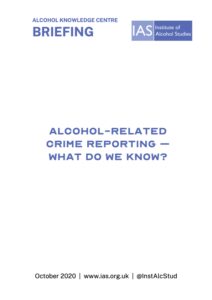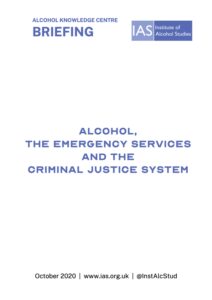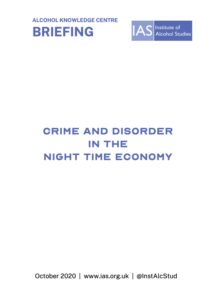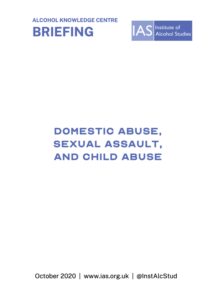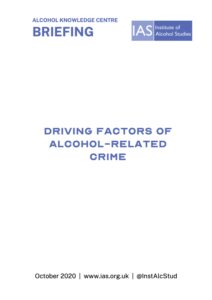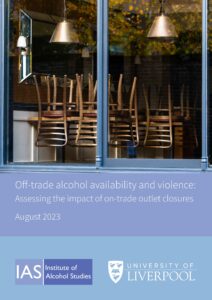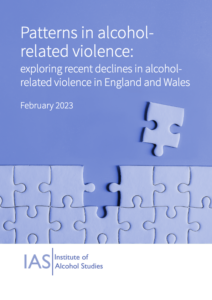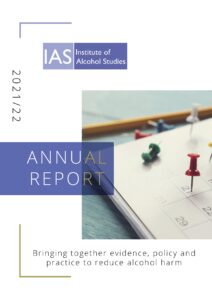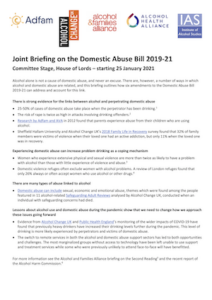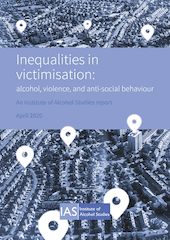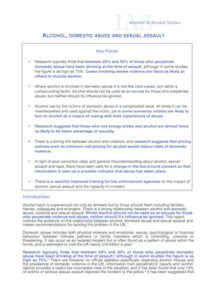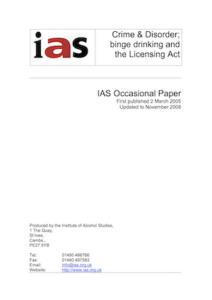On this page
Alcohol is seen as a significant contributory factor in many kinds of crime in Britain today – it is associated with over 4 million crimes in the UK each year, including 500,000 violent crimes. Indeed, research has highlighted the role alcohol can play in domestic violence, sexual assault, child abuse, and violent crime including murder.
It is estimated to cost £14.58 billion in England alone, including costs to the police and criminal justice system, cost of stolen or damaged property, and money spent on crime detection and prevention.
Alcohol also places a significant burden on the emergency services – three quarters of police and half of ambulance respondents have been injured in alcohol-related incidents.
There has been a decline in the volume of alcohol-related violence reported to the Crime Survey for England and Wales in recent years, alongside a broader decline in violence overall. However, two-fifths of the violent incidents captured in the survey are reported as alcohol-related.
A number of drivers of alcohol-related crime identified include price, the density and types of premises selling alcohol (also referred to as its physical availability), and extended drinking hours (also referred to as its temporal availability). Policies aiming to address these drivers exist at both a national and local level in the UK – for example, licensing regulation placing controls on where, when, and how alcohol can be sold. Research suggests Minimum Unit Pricing also presents an effective policy option.
Facts and stats
- In 2022/23, 38% of all violent crimes occurred where the victim believed the offender(s) to be under the influence of alcohol (ONS, 2024, Table 9a).
-
How much crime is alcohol-related in England and Wales? by The Institute of Alcohol Studies
- In 2022/23, 38% of domestic violence incidents occurred when the victim believed the offender(s) to be under the influence of alcohol or drugs.
How much domestic violence is alcohol-related in England and Wales? by The Institute of Alcohol Studies
- The proportion of violent crimes involving offenders under the influence of alcohol has fallen from just over 3 in 5 in 2008/09 to around 2 in 5 in 2019/20
How much crime is alcohol-related in Scotland? by The Institute of Alcohol Studies
- Survey data is unavailable. However, police data suggests the following:
- Between 2012/13 and 2021/22, around one in five crimes recorded by the police have been flagged with an alcohol motivation.
- There were 23,046 of such offences in 2021/22
- Sexual offences with an alcohol motivation represented 14.3% of all sexual offences in 2020/21
- Around half of all violence with injury offences and two fifths of violence without injury offences have been given an alcohol motivation. (PSNI, 2022)
- When on-trade outlets were closed during the pandemic, there was only a very small decrease in the proportion of violence that was alcohol-related – 15.5% to 12.8% (Lightowlers and Bryant 2023).
- Closures did not lead to significant differences in the level or proportion of domestic violence flagged as alcohol-related.
- This suggests that the impact of alcohol sold in off-trade sites – not only on-trade – ought to be considered as a component of efforts to reduce violence.
- England and Wales: 13,000 Penalty Notices for Disorder (PND) were issued in relation to non-notifiable offences for the year ending September 2017, the majority of which related to drunk and disorderly behaviour. (ONS, 2018)
- Scotland: Consuming alcohol in a public place was the third most commonly issued Anti-Social Behaviour Fixed Penalty Notice (ASBPN) in 2017/18, making up 1/5 of all notices given. (Scot Gov, 2019)
- Northern Ireland: Data is not held for exactly how many PNDs issued are related to alcohol, although there is one offence referring specifically to alcohol related behaviour – ‘simple drunk’ – for which 41 PNDs were issued in 2016.
- A survey examining the North West of England found that:
- 43% of respondents felt annoyed by people vomiting or urinating in the street after drinking
- 49.4% were kept awake by drunken noise
- Over 1 in 10 perceive people being drunk or rowdy in their area to be a very or fairly big problem. (ONS, 2023)
- Alcohol is the second most commonly identified major cause of crime in Northern Ireland
What are the public’s perceptions of alcohol-related crime in Northern Ireland? by The Institute of Alcohol Studies
Briefings
Reports
Blogs

Gone but not forgotten: Why was the Northern Territory’s Minimum Unit Price removed?
1st April 2025
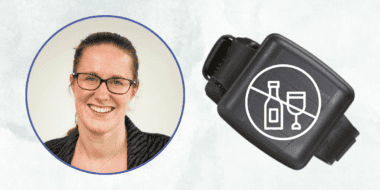
Do alcohol ‘sobriety tags’ reduce reoffending?
21st January 2025

Alcohol and Homicide: A Sobering Look at Violence in Latin America and the Caribbean
24th September 2024

Can alcohol control policies reduce family and domestic violence?
17th September 2024

Limits on bar/tavern hours of sale: an important tool in a violence prevention toolbox?
13th August 2024

Isolating and Examining Off-Trade Availability and Violence
18th September 2023

Can alcohol duties be used to reduce the rate of violence injury?
20th June 2023
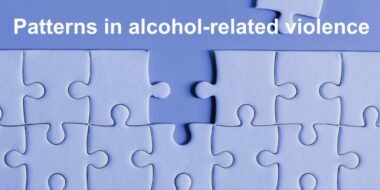
Patterns in alcohol-related violence: exploring recent declines in alcohol-related violence in England and Wales
27th February 2023

